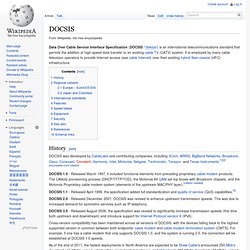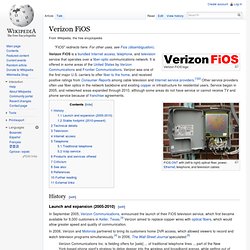

Passive optical network. Downstream traffic in active (top) vs. passive optical network History[edit] Two major standard groups, the Institute of Electrical and Electronics Engineers (IEEE) and the Telecommunication Standardization Sector of the International Telecommunication Union (ITU-T), develop standards along with a number of other industry organizations.

The Society of Cable Telecommunications Engineers (SCTE) also specified radio frequency over glass for carrying signals over a passive optical network. FSAN and ITU[edit] Starting in 1995, work on fiber to the home architectures was done by the Full Service Access Network (FSAN) working group, formed by major telecommunications service providers and system vendors.[1] The International Telecommunications Union (ITU) did further work, and standardized on two generations of PON. By mid-2008, Verizon had installed over 800,000 lines.
Security[edit] IEEE[edit] There are currently[when?] Network elements[edit] Upstream bandwidth allocation[edit] Wavelength-division multiplexing. The term wavelength-division multiplexing is commonly applied to an optical carrier (which is typically described by its wavelength), whereas frequency-division multiplexing typically applies to a radio carrier (which is more often described by frequency).

Since wavelength and frequency are tied together through a simple directly inverse relationship, in which the product of frequency and wavelength equals c (the propagation speed of light), the two terms actually describe the same concept. WDM systems[edit] WDM operating principle The concept was first published in 1978, and by 1980 WDM systems were being realized in the laboratory.
The first WDM systems combined only two signals. WDM systems are popular with telecommunications companies because they allow them to expand the capacity of the network without laying more fiber. Most WDM systems operate on single-mode fiber optical cables, which have a core diameter of 9 µm. Early WDM systems were expensive and complicated to run.
Muxponder. DOCSIS. Data Over Cable Service Interface Specification (DOCSIS /ˈdɒksɪs/) is an international telecommunications standard that permits the addition of high-speed data transfer to an existing cable TV (CATV) system.

It is employed by many cable television operators to provide Internet access (see cable Internet) over their existing hybrid fiber-coaxial (HFC) infrastructure. History[edit] DOCSIS was developed by CableLabs and contributing companies, including 3Com, ARRIS, BigBand Networks, Broadcom, Cisco, Conexant, Correlant, Harmonic, Intel, Motorola, Netgear, Technicolor, Terayon, and Texas Instruments.[1][2][incomplete short citation] DOCSIS 1.0 - Released March 1997, it included functional elements from preceding proprietary cable modem products: The LANcity provisioning process (DHCP/TFTP/TOD), the Motorola 64 QAM set top boxes with Broadcom chipsets, and the Motorola Proprietary cable modem system (elements of the upstream MAC/PHY layer). [citation needed] Regional variants[edit] Throughput. Verizon FiOS. Verizon FiOS logo FiOS ONT with (left to right) optical fiber, power, Ethernet, telephone, and television cables History[edit] Launch and expansion (2005-2010)[edit] In September 2005, Verizon Communications, announced the launch of their FiOS television service, which first became available for 9,000 customers in Keller, Texas.[3] Verizon aimed to replace copper wires with optical fibers, which would allow greater speed and quality of communication.

In 2006, Verizon and Motorola partnered to bring its customers home DVR access, which allowed viewers to record and watch television programs simultaneously.[4] In 2006, The Wall Street Journal speculated:[5] Verizon Communications Inc. is fielding offers for [sale] ... of traditional telephone lines ... part of the New York-based phone giant's strategy to delve deeper into the wireless and broadband arenas, while getting out of the traditional phone business in U.S. areas that aren't slated for fiber upgrades ... Availability in 2008.
Fiber Optics.